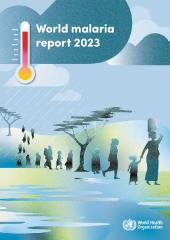World Malaria Report: Decades of progress undone

On 30 November, the WHO published its annual report on the state of the global response to malaria. The report reveals unsettling figures that point to a deterioration compared with 2019, prior to the Covid-19 pandemic. 2022 saw 249 million cases of malaria and 608,000 deaths, up significantly from the 233 million cases and 576,000 deaths recorded three years earlier, with Africa accounting for 95% of malaria cases and deaths.
The increase in the incidence rate was largely concentrated across only five countries: Pakistan (2.1 million additional cases), followed by Ethiopia and Nigeria (1.3 million each), Uganda (597,000) and Papua New Guinea (423,000). Children under the age of five carry the overwhelming burden of the disease, accounting for 80% of deaths.
An array of factors behind the rise in malaria cases
Behavioural changes among malaria-carrying mosquitoes, together with the spread of resistance to insecticides and treatments, stand out as prime factors behind the intensification of the malaria pandemic. In East Africa, cases of parasite resistance to artemisinin, the basic molecule used to treat malaria, are becoming increasingly frequent. In addition to drug resistance, mosquitoes themselves are developing resistance to insecticides, particularly those used on insecticide-treated nets or ITNs, the most effective method available to date.
The case of Pakistan highlights the impact of climate change on the disease. The exponential rise in the number of malaria cases in the country is attributable to the massive flooding that covered 10% of Pakistani territory, turning the country into a breeding ground for mosquitoes, destroying infrastructure and preventing people from accessing health services. Climate change can also have an indirect effect on the vulnerability of populations exposed to malaria, for example by increasing child undernutrition and prompting population displacements that disrupt the continuity of essential prevention, diagnosis and treatment services. Climate change is recognised by the WHO as one of the leading threats to human health.
Ongoing conflicts, particularly in Ethiopia and Myanmar, are hampering access to health services and have also led to a rise in malaria cases in both countries.
Innovations with limited impact
A number of innovations in the field of prevention mark significant progress against the disease.
The WHO has authorised the use of two vaccines, RTS,S and R21, both recommended for children five months and older. Although not a magic bullet that can end malaria on their own, vaccines will nonetheless save lives when combined with other vector control tools. Used alone, RTS,S reduces cases of severe malaria in children aged five to 17 months by a mere 30%. However, when administered together with another prevention method, seasonal malaria chemoprevention, the vaccine contributes to a 70% drop in case numbers. The R21 vaccine is expected to help reduce malaria cases by 75% in the year following the recommended three injections; however, data on the impact of the R21 vaccine on severe malaria are not yet available. As such, vaccines must not be seen as a replacement for existing vector control tools, but rather as an additional weapon to be incorporated into a multi-pronged strategy combining prevention and universal access to healthcare.
Next-generation insecticide-treated bed nets hold great promise to counter the spread of insecticide resistance, but they remain more costly than conventional nets. At current funding levels, a choice must be made between two imperfect alternatives: supplying the new nets to fewer people, or maintaining coverage levels with less effective ITNs. To make matters worse, malaria-endemic areas are mainly concentrated in low-income countries that lack the capacity to fund prevention, diagnostic and treatment programmes at levels commensurate with need.
If progress continues at the present rate, efforts will fall short of malaria elimination targets, including the upcoming milestone of a 75% reduction in incidence and mortality by 2025 from the 2015 baseline. 2022 investments in malaria programmes came to only USD 4.1 billion, well below the USD 7.8 billion required (and the target of USD 9.3 billion for 2025). Moreover, research and development spending was a mere USD 608 million, the lowest level in the past 15 years.
The Global Fund alone provides 65% of international funding for malaria programmes. Its integrated approach enables all stakeholders – national governments, the private sector, communities, international organisations and NGOs – to work together to adopt the best possible response to malaria in the countries where the Fund operates. It also allows greater access to innovations such as next-generation ITNs.
In view of the radical shifts underway in the malaria pandemic, linked in particular to the increase in resistance to treatments and the acceleration of climate change, and exacerbated by an under-financed response, Friends of the Global Fund Europe calls on G7 leaders to make the fight against malaria a key global health priority.
A renewed G7 commitment to strengthen the multilateral and multi-partner approach to the fight against malaria, ensure that malaria programmes and research are funded commensurate with need, and promote access to healthcare products and services for malaria-affected populations based on a One Health approach, is indispensable. In the absence of such a commitment, the target of eliminating malaria by 2030 will be nothing more than wishful thinking.
